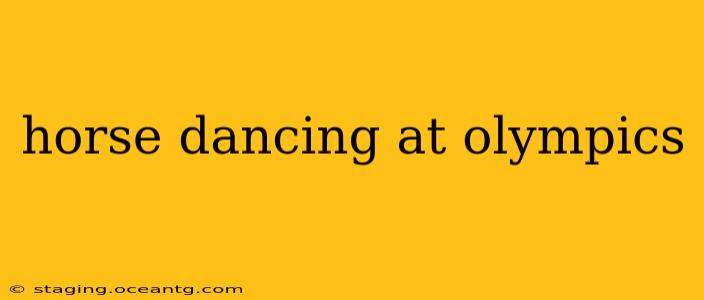The idea of "horse dancing" at the Olympics might conjure images of horses performing intricate ballet routines. While that's not quite the reality, the equestrian events at the Olympic Games are a captivating blend of athleticism, skill, and partnership between horse and rider, often showcasing remarkable grace and precision that some might consider a form of "dance." This article delves into the world of Olympic equestrian sports, clarifying what's actually involved and addressing common misconceptions.
What Equestrian Events Are in the Olympics?
The Olympic equestrian program features three core disciplines:
-
Dressage: Often described as the "ballet of horses," dressage involves highly trained horses executing a series of precise movements in an arena. The movements, judged on their precision, balance, and harmony with the horse, are choreographed to demonstrate the horse's suppleness, obedience, and athleticism. It's a test of both the rider's skill and the horse's training.
-
Eventing: This thrilling three-day competition combines dressage, cross-country, and show jumping. It demands incredible versatility and stamina from both horse and rider. Each phase presents unique challenges: dressage tests precision and obedience, cross-country tests speed and endurance over challenging terrain, and show jumping tests precision and jumping ability over a series of obstacles.
-
Show Jumping: Show jumping focuses solely on the horse's ability to clear a course of obstacles. It emphasizes speed, precision, and athleticism. Horses must demonstrate powerful jumps and accurate navigation, while riders must maintain balance and control.
Are there any "dancing" elements in Olympic equestrian events?
While there's no literal dancing involved, the grace and elegance displayed, especially in dressage, often draw comparisons to dance. The fluid movements, the harmonious partnership between horse and rider, and the intricate choreography of the routines all contribute to a performance that is both breathtaking and artistic. The precision and control required are comparable to the dedication and skill found in professional dancers.
What are the judging criteria for Olympic equestrian events?
Judging criteria vary slightly across the three disciplines but generally focus on:
- Accuracy and Precision: Correct execution of movements and jumps.
- Harmony and Balance: The seamlessness of the horse's movements and the rider's control.
- Speed and Efficiency: Time taken to complete the course (relevant to eventing and show jumping).
- Style and Presentation: The overall aesthetic appeal of the performance (particularly important in dressage).
How are the horses chosen for the Olympics?
The selection process for Olympic horses is rigorous. Horses must demonstrate exceptional talent, athleticism, temperament, and training. They are carefully selected and prepared by dedicated riders and trainers, often undergoing years of intense training to reach Olympic level.
What is the training process like for horses in Olympic equestrian sports?
Olympic horses undergo extensive training, often starting at a young age. This involves a gradual progression of increasingly complex exercises to build strength, stamina, and obedience. The relationship between horse and rider is crucial, as it takes years of trust and communication to achieve the level of harmony displayed at the Olympics.
What are some famous Olympic equestrian moments?
Olympic history is filled with memorable moments of athletic prowess and thrilling victories in equestrian events. Specific highlights depend on individual preferences, but researching past Olympics and notable equestrian athletes will reveal many compelling stories of dedication, teamwork, and breathtaking performance.
In conclusion, while not literally "horse dancing," Olympic equestrian events showcase an extraordinary level of athleticism, skill, and artistry. The precision, grace, and harmony between horse and rider in disciplines like dressage are truly captivating, and the challenges of eventing and show jumping are equally impressive. These events are a testament to the dedication and talent of both the horses and the riders, representing a unique and thrilling aspect of the Olympic Games.
